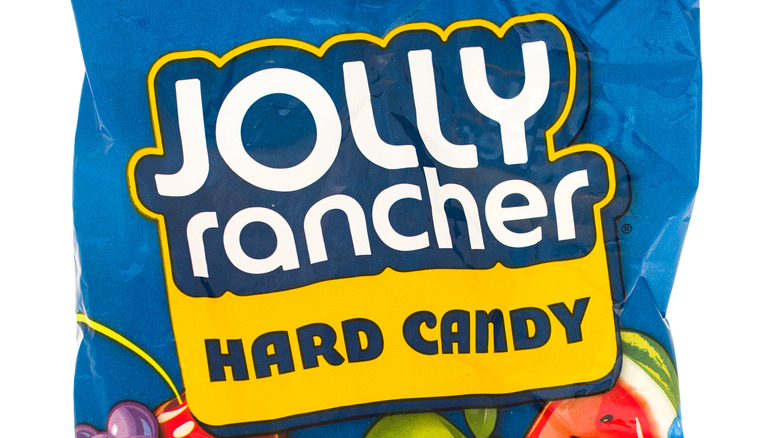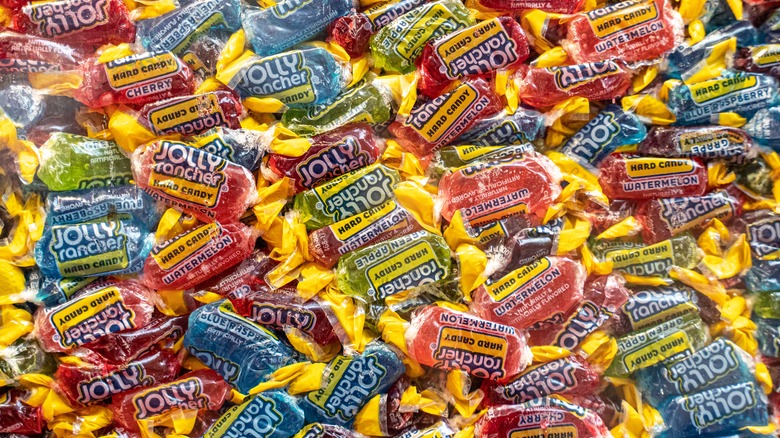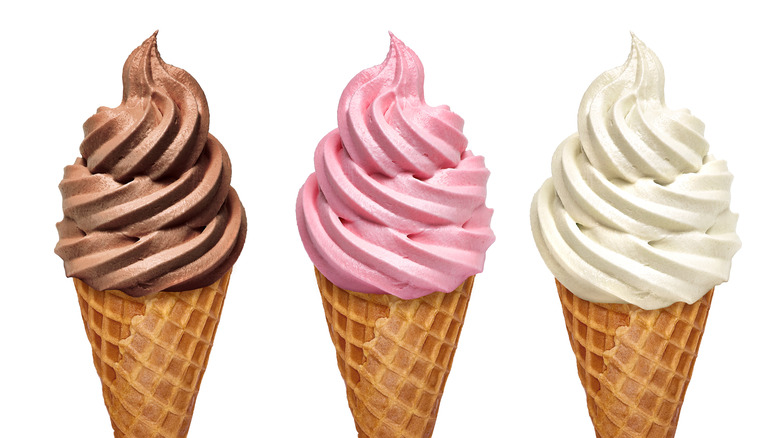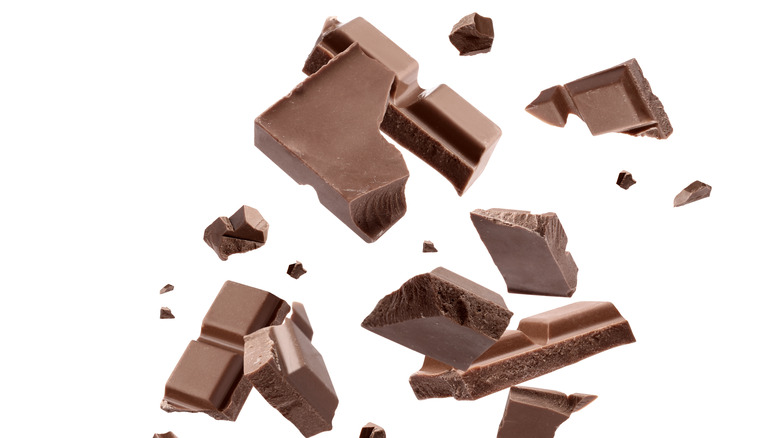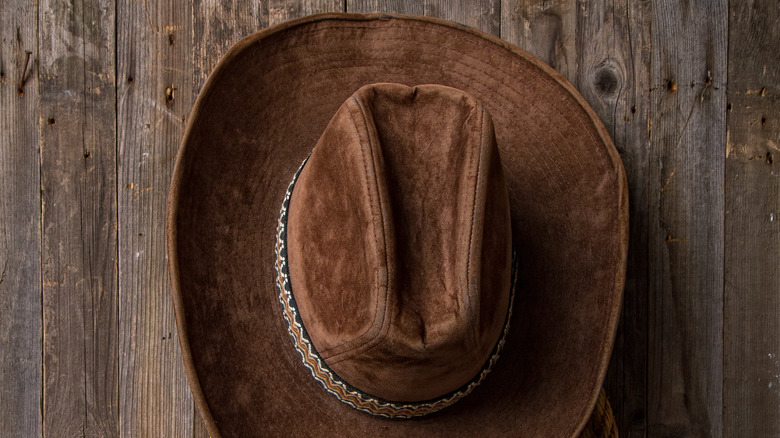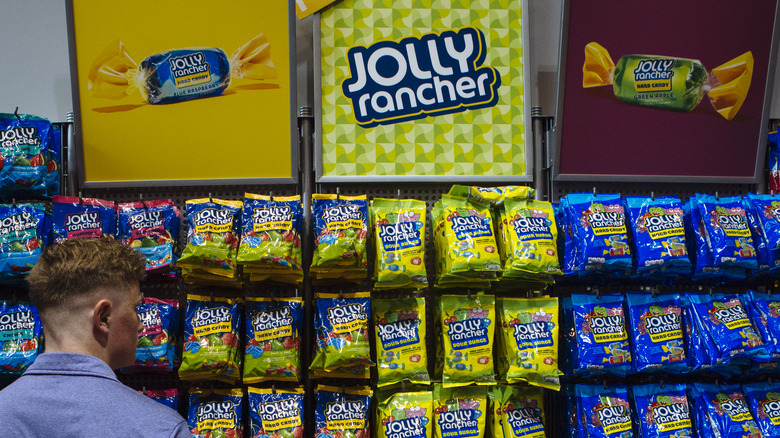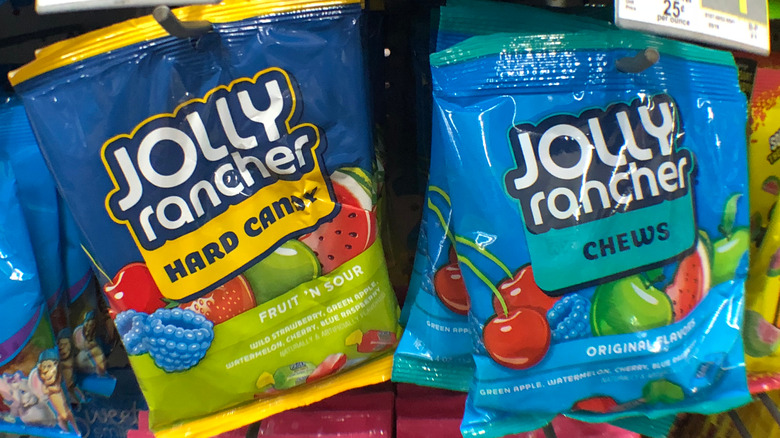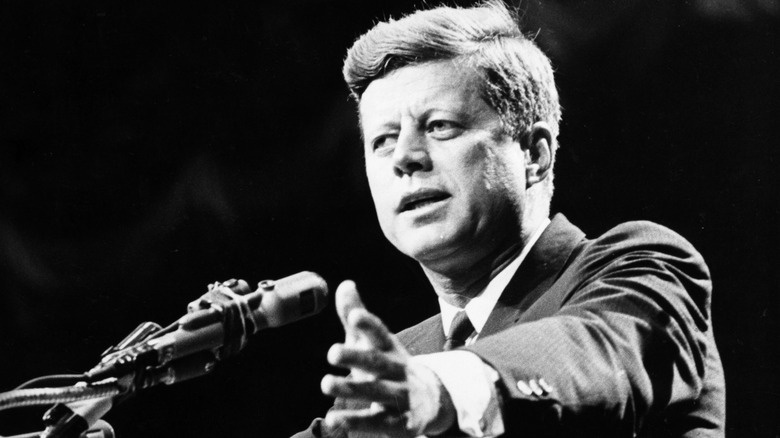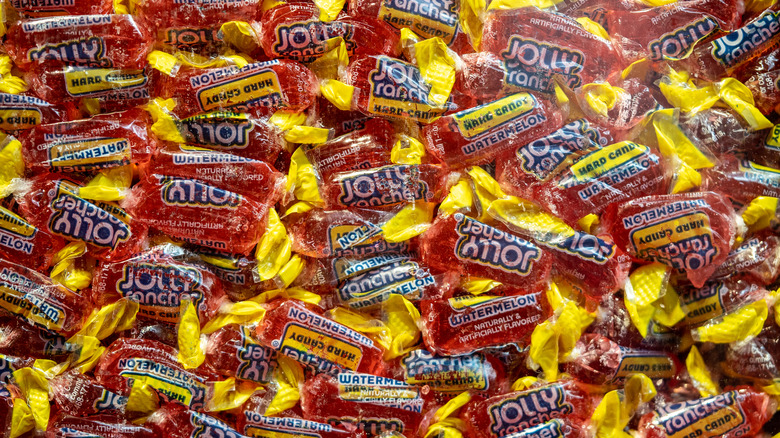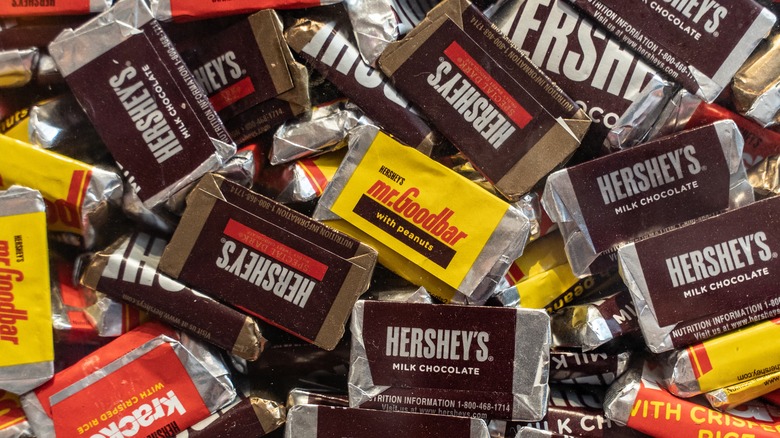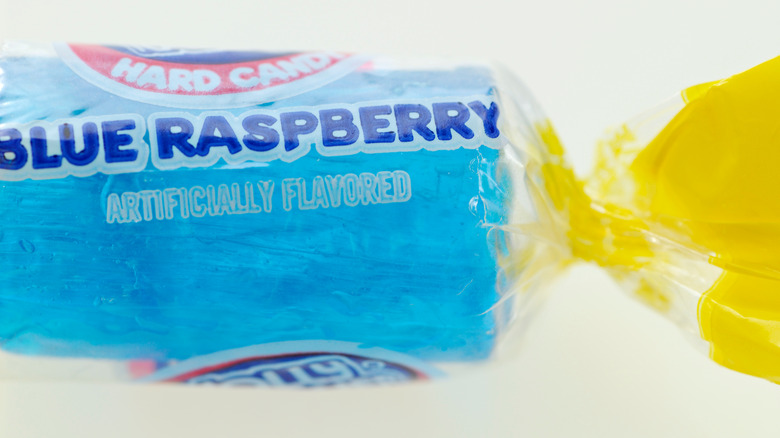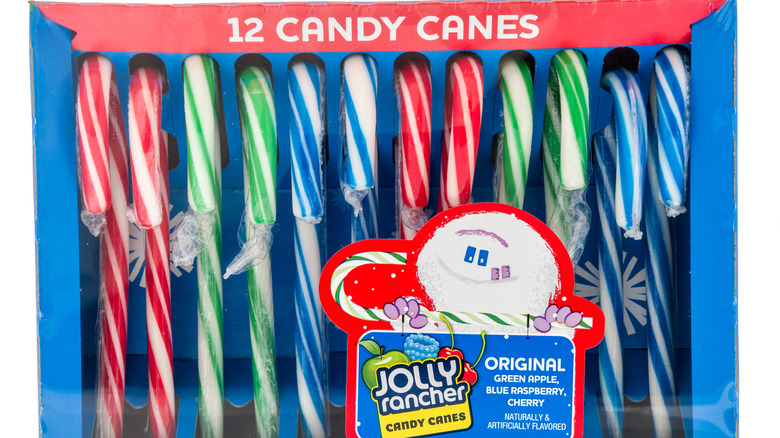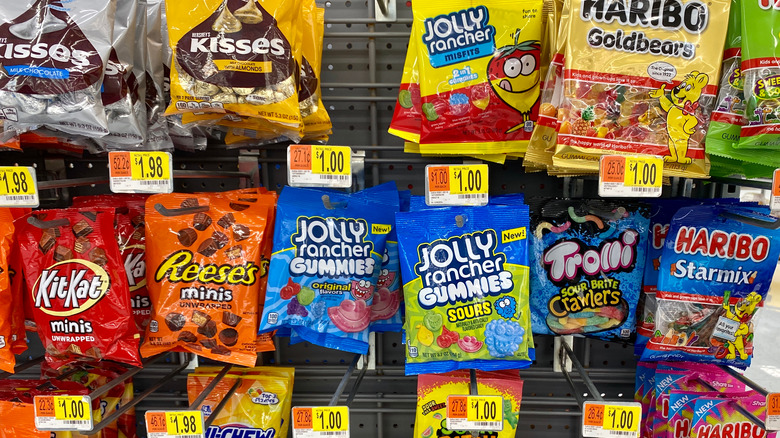The Untold Truth Of Jolly Rancher
We may receive a commission on purchases made from links.
A flavor-dense candy with a bucolic name, Jolly Rancher is not for the impatient imbiber. As any hard candy expert can attest, popping a Jolly Rancher into your mouth is merely the nascence of your endeavor, a journey that doesn't conclude until that hard Rancher is fully dissolved, or you tempt fate by swallowing down a glassy shard of sour apple.
With a rigid consistency that reshaped the candy zeitgeist in the 1950s, Jolly Rancher is still running strong in the hard candy category while expanding its repertoire. From sticks to cubes to taffy, this leading candy company has its formulations down to a science, selling a ton of it in nearly every form.
Believe it or not, it would take a few iterations before Jolly Rancher hit its stride. There were pivots and there were pitfalls, but fortune soon favored its bold flavor, resulting in a unique product with a unique history that still transcends its competition today.
Jolly Rancher was founded by a commercial airline pilot and an aspiring fruit grower
Jolly Rancher began both as a physical location and an offshoot idea of Dorothy and Bill Harmsen, a husband-and-wife team who uprooted their life in Minnesota and moved to Colorado in 1942. They purchased a farm in Wheat Ridge, just on the outskirts of Golden, according to the Golden History Museum & Park website.
Before sliding their chips all-in, Bill was an airline pilot who aspired to be a business owner, but it was Dorothy who first put her own entrepreneurial spirit to work by cultivating flowers and fruit for sale. According to a booklet written by Dorothy herself, Bill would fly planes for two more years while she took the helm of Jolly Rancher's first business. She sold raspberries, strawberries, peonies, and gladiolas to buyers in Denver, but the commute wasn't ideal. So the couple's business pivoted — Dorothy and Bill set up a woodworking shop on their farm and catered to niche markets by specializing in cocktail trays and doll beds.
After seven years of various ventures, Dorothy and Bill opened the first Jolly Rancher store in 1949. And shockingly enough, not even this place was known for its hard candy, but instead its soft-serve ice cream.
Jolly Rancher started off as an ice cream brand
On May 28, 1949, the Jolly Rancher ice cream store was born. The Golden History Museum & Park website explains the origins of its name: "Rancher gave the store a western aura and Jolly suggested a friendly atmosphere." While living in Minneapolis, Dorothy and Bill Harmsen had also once resided at the Jolly Miller Hotel, per The New York Times.
The Harmsens leaned full force into the rustic setting of their new business. Customers entered the Golden, Colorado, shop right after passing under the famous "Howdy Folks, Welcome to Golden!" arch, primed for the aesthetic.
The location fit perfectly to the company's demeanor, and selling soft-serve ice cream was considered a hot business in the clear-skied Colorado summers. But winter was coming, and it would prove problematic. The revenue from summer sales wasn't enough to cover overhead, and since it was near impossible to run an ice cream shop during Rocky Mountain winters, the Harmsens were forced to scramble to find a solution, or Jolly Rancher would be a failure during launch. Luckily, they already had considerable business experience under their belt and could count on their newfound culinary experience to save them.
The company produced chocolate to stave off early struggles to its bottom line
As the Jolly Rancher ice cream machines failed and their overhead soared into untenable territory, Bill and Dorothy Harmsen resorted to selling chocolate to stave off their mounting debt. Paul McCartney himself said the Beatles made their best music with their "backs against the wall," and in this analogous situation, Bill and Dorothy made their best chocolate. A pinch-hit that flew for a home run, the Harmsens not only recouped their losses by selling boxes of chocolate, but began franchising new Jolly Rancher locations in Colorado, Nebraska, and Wyoming because of this breakout success.
Improvised chocolatiering bought the Harmsens time to develop new candy formulas, and this was likely the biggest boon of all. As history would dictate, the Jolly Ranchers we know today would have never existed if it weren't for the Harmsens' surprisingly skilled pivot into chocolate.
Its original rustic headquarters was known as Sugar Bar Ranch
Jolly Rancher would soon settle into its identity in the early 1950s as sales of its hard candy began to overtake both chocolate and ice cream. This success prompted renovations on Bill and Dorothy Harmsen's 10-acre farm near Golden, Colorado, and inspired the property's new moniker: Sugar Bar Ranch.
The success of Sugar Bar Ranch shifted Jolly Rancher's priority for production. The barn that formerly held fruits and flowers for sale was renovated into a hard candy manufacturing facility. As their business expanded in size and narrowed in scope, the Harmsens added kitchens to their barn and employees to their confectionery roster.
On the outside, the barn held its rustic look, but on the inside, Jolly Rancher's first hired candy makers were hard at work, doing their best to keep up with the insane demand of a popular new product: A cinnamon-flavored taffy with a spicy kick, known at that time as Jolly Rancher Fire Stix.
The hard candy took off with the success of Fire Stix in the 1950s
Jolly Rancher's breakout success had nothing to do with the cuboid candies we're fond of today, but instead a cinnamon-flavored hard taffy known as Jolly Rancher Fire Stix.
The rage for these hot candies began back when Jolly Rancher was an ice cream store selling chocolate to survive in the late 1940s and early 1950s. Along with buyers asking for orders of chocolate, many would also request the "five cent hot cinnamon taffy" sticks.
Demand for Fire Stix soared so high that Jolly Rancher began making them on-site and, in turn, pivoted to the positive side of the sales ledger. As Fire Stix spun hot off the lines, Jolly Rancher introduced Fire Stix Kisses. A cinnamon hard candy pre-formed in an odd geometry and wrapped at both ends, Fire Stix Kisses first adopted the look and feel of the Jolly Rancher hard candy we enjoy today.
Jolly Rancher published a magazine titled Sugar and Spice
In 1961, Dorothy Harmsen, along with Mildred Uhlig and Bud Hilker, formed the three-person staff of the Jolly Rancher trade publication "Sugar and Spice," a monthly newsletter sent out to employees and customers that kept them updated on the state of the company. It also featured entertaining stories and "unusual" photos that leaned into Jolly Rancher's initially Western and folksy sensibilities.
In 1963, Jolly Rancher went so far west that the Harmsens hired Disney sketch artist Bob Cormack to draw pistols reminiscent of the wild frontier days. Published as lithographic drawings, Cormack provided six sketches for the publication, as well as backstories behind the historically significant firearms.
The trade publication is no longer available today, but two leatherbound anthologies of the newsletter are archived at the Golden History Museum & Park in Golden, Colorado, preserving the pulse of Jolly Rancher in a period spanning from 1961 to 1983.
Jolly Rancher candy and cowboy gear were gifted to President John F. Kennedy in 1960
In 1960, Jolly Rancher was a young company, and John F. Kennedy was about to become a young president. Although he had Addison's disease, which causes symptoms including nausea and fatigue, Kennedy still canvassed at high energy, campaigning all over the country against his rival Richard Nixon.
This successful and frenetic tour would take Kennedy through Denver, Colorado, where he made an unusual campaign stop. Standing out on the tarmac in front of his private plane, The Caroline, Kennedy met with Jolly Rancher proprietors Dorothy and Bill Harmsen and was presented with some Wild West Jolly Rancher swag.
The Harmsens gifted the future POTUS a pair of cowboy boots, a Stetson-style cowboy hat, and a big box of Jolly Rancher candy. Although a far cry from the image of Camelot, Kennedy accepted the gifts with a smile and went on to win the presidency.
Watermelon is the most popular Jolly Rancher flavor
With an array of bold flavors on offer, it's always tough to decide which Jolly Rancher is the best in the bag. But although all tastes are subjective, it's easy to see which flavors are the most popular. According to Jolly Rancher, the varieties that candy connoisseurs love most are blue raspberry, cherry, green apple, grape, and watermelon. At the time of this writing, the latter fruit occupies the Jolly Rancher apex, with the bright pink candy being the variety that fans reach for more than any other flavor in the brand's arsenal.
The flavor is so incredibly popular that Jolly Rancher sells bags of watermelon hard candy exclusively, a success it extended down the line with single-variety bags of "All Peach" and limited-variety bags such as "Awesome Reds," which features watermelon, cherry, strawberry, and fruit punch. And if you're really into assortments, Jolly Rancher dishes up hard candy in Tropical, Fruity Bash, and Wild Berry varieties. But no matter the permutation, watermelon remains its most popular, as evidenced by the 160-piece box of the candies that customers can purchase on the Jolly Rancher website.
Jolly Ranchers are made by The Hershey Company
Jolly Rancher started off as independently owned and would remain so until 1967 when it was bought by Beatrice Foods after merging a year prior. Jolly Rancher would shuffle agreements again in 1983 when it was purchased by Leaf Inc. before being acquired by The Hershey Company in 1997.
Sales surged for Hershey shortly after the deal, according to a 1998 CNN Money report, and the two titans of candy have stayed enjoined ever since. Hershey continues producing Jolly Ranchers candies and expanding the brand's offerings, filling out a laundry list of options and crossovers made possible when you combine two of the biggest names in candy. The Hersheyland website lists 39 different Jolly Rancher products as of this writing, including a hybrid assortment of Jolly Rancher Pull 'n' Peel Twizzlers, which are almost too wild to imagine. Seasonal items, such as a bag of jellybeans shaped like hearts for Valentine's Day, are another newer addition to the lineup. Aside from the experimental concoctions, you can also find Jolly Rancher's typical assortment of hard candy, fruit chews, and gummies.
The NYPD once mistook a man's Jolly Ranchers for crystal meth
Attempting to catch someone breaking bad, an NYPD officer made a humiliating mistake when he seized a haul of Jolly Ranchers. According to the New York Daily News, the NYPD didn't rule out crystal meth until they tested "red crystalline rocks of solid material" and "blue crystalline rocks of solid material" through gas chromatography and mass spectrometry. This may seem a little hardcore, but Mike Levine, a former DEA agent, would tell the outlet that meth and Jolly Ranchers can look a lot alike, stating that meth dealers will "disguise their product in any way you can imagine."
That's scary to know but makes it easier to understand how a mistake like this can happen — a mistake that would come with additional consequences, as the falsely apprehended Love Olatunijojo would file a lawsuit against the NYPD. He and two companions, who also spent the night in jail for a crime they didn't commit, were later awarded a total of $33,000, per the New York Daily News.
The brand also makes lollipops and candy canes
Although regarded for its hard candy's iconic geometry, Jolly Rancher is not limited by it. Produced under The Hershey Company flagship, Jolly Rancher has also tossed its bold flavor into lollipops and candy canes. The candy canes are designated as holiday items and come in a variety 12-pack of green apple, blue raspberry, and cherry. The packaging is accordingly festive with wintry snowfall serving as the motif.
The lollipops can be found in three of the original Jolly Rancher flavors – green apple, cherry, and watermelon — as well as pink lemonade. They also come combined in assorted packs with traditional Jolly Rancher hard candy. But that's not all — Jolly Rancher has a seasonal lollipop offering with its Valentine Exchange lollipops and offers them in the same four flavors. The edible valentines come wrapped in packaging with an address line so you don't have to send these heart-shaped charms as a secret admirer.
Jolly Rancher surpassed $100 million in yearly hard candy sales in 2020
With a formula that's worked since the middle of the last century and constant improvements upon its candy craft, including taking risks on bold new products like its cherry lemonade, it's easy to see why Jolly Rancher is one of the best at reeling in the profit. With other candy companies struggling with sales throughout the COVID-19 pandemic, Jolly Rancher's revenue saw nine figures by being one of the world's few mainstays in that market. Comfort food appeared to aid in uncomfortable times, as Jolly Rancher cleared $120 million in hard candy sales in 2020, according to Candy Industry. The company followed up in 2021 with over $130 million in revenue, per Statista.
Keep in mind, the sales are not just reflective of Jolly Rancher's leading hard candy, but also its line extensions: a product tree branching out to bubble gum and cherry-filled gummies, bearing over 30 distinct offerings, mash-ups, and cross-brand combinations.
